The concept of industrial mother machine soared in early trading, and individual stocks in the sector set off a wave of daily limit. Nearly 10 stocks such as Genesis, Kede CNC, Chunhui Intelligent Control, Huachen Equipment, Zheheideman and other nearly 10 stocks have 20% daily limit, and Huadong CNC, Deen Precision More than 20 shares of Lixing, Lixing and Haitian Precision have their daily limit or over 10%. ST Tianma, which is mainly engaged in the research, production and sales of bearings and machine tools, also has a daily limit, and its share price has performed well recently.
“Industrial host computer” Why did it suddenly become popular? On the news, the State-owned Assets Supervision and Administration Commission recently held a meeting and pointed out that technological innovation should be placed in a more prominent position, and central enterprises should be actively integrated into national basic research and applied basic research. Innovate the system, strengthen key core technology research for industrial mother machines, high-end chips, new materials, new energy vehicles, etc., strive to create original technologies “sources”, shoulder the responsibility of the industrial chain “chain owners”, and carry out chain-strengthening Special actions to strengthen synergy between upstream and downstream industries, and actively promote the development of small, medium and micro enterprises.
So what is the current development of the domestic "industrial base machine"? What is the importance of its industrial chain? What is the situation of domestic and foreign competition? With questions, let's take a look at the "industrial base machine".
The machine tool is called the "industrial master machine" and is one of the most important tools for industrial production. The upstream of the machine tool industry is mainly basic materials and parts, including structural parts, cast iron, steel, CNC systems, drive systems, transmission systems, etc.

Chart: Machine tool upstream and downstream industry chain
There are many types of machine tools, and metal cutting machine tools are the most widely used. According to material forming methods, machine tools can be divided into eight sub-sectors: metal cutting machine tools, metal forming machine tools, casting machinery, woodworking machinery, machine tool accessories, measuring tools and measuring instruments, abrasives and other metal processing machinery. Among them, metal cutting machine tools are the most widely used and most numerous machine tool category. Generally speaking, the machine tool in the narrow sense refers to the metal cutting machine tool. Metal cutting machine tools refer to machine tools that use cutting, grinding or special processing methods to process various metal workpieces to obtain the required geometric shapes, dimensional accuracy and surface quality.
According to the classification of machine tool control systems, machine tools can be divided into traditional machine tools and CNC precision machine tools. CNC machine tools refer to automated machine tools equipped with a program control system.
CNC machine tools can be divided into ordinary CNC machine tools and machining centers according to the processing methods. Ordinary CNC machine tools generally refer to automatic machine tools that realize digital control in a process in the processing process, such as CNC milling machines, CNC lathes, and CNC. Drilling machines, CNC grinding machines and CNC gear processing machine tools, etc. Ordinary CNC machine tools are not fully automated in terms of automation, and the replacement of tools and the clamping of parts still need to be completed manually.
The machining center is a CNC machine tool with a tool magazine and an automatic tool changer. It combines the functions of a CNC milling machine, a CNC boring machine, and a CNC drilling machine. After the parts are clamped once, most of their machining surfaces can be processed. Multi-process machining such as milling, boring, drilling, expanding, reaming and tapping. Since the machining center can effectively avoid positioning errors caused by multiple installations, it is suitable for products with frequent product replacements, complex shapes of parts, high precision requirements, small production batches and short production cycles.
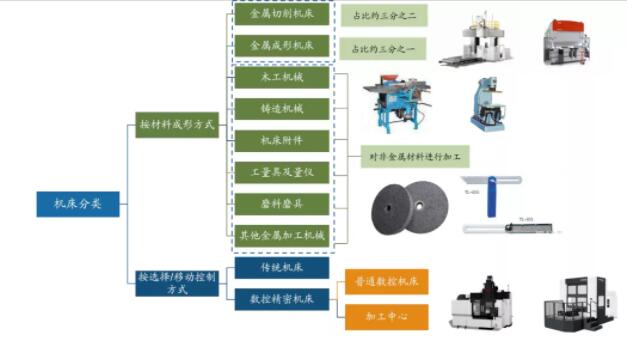
Chart: Machine Tool Classification
Introduction to the core components of CNC machine tools
CNC machine tools are mainly composed of structural parts (castings, sheet metal parts), CNC system, drive system (spindle drive unit, feed unit, spindle motor), transmission system (spindle, screw, guide rail), tool magazine, tool Tower and components, etc.
After processing, the structural parts form the bed body and protection system, etc., which are the frame of the CNC machine tool;
Numerical control system is the control core, which realizes the generation and transmission of metal cutting commands through programming;
The drive system executes the commands of the CNC system to realize the movement of machine tool components;
The transmission system mainly includes main shaft, lead screw, guide rail and other components. Both the main shaft and lead screw are the motion transmission parts of CNC machine tools. The main shaft converts the rotation into cutting of the tool, and the lead screw converts the rotation of the motor into the linear motion of the workpiece. Rotating movement, the guide rail plays a supporting role;
The tool magazine, turret and components realize the function of automatic tool change.
According to Haitian Precision's prospectus, the cost of structural parts, CNC system, drive control system, transmission system, tool magazine, turret and components accounted for 35%, 22%, 13%, and 20 of the total cost of CNC machine tools, respectively. %, 5%.
With the rapid development of the world's intelligent manufacturing equipment technology, high-precision, high-speed, high-efficiency, and high-stability have become the main measurement indicators of CNC machine tools, and constitute the focus of technology research and development in the industry at this stage. Accuracy determines the quality of processed products, speed and processing efficiency determine processing capacity, and stability determines the trouble-free maintenance of equipment performance. Spindles, tool magazines, turrets, cutting tools, CNC systems, guide rails, and lead screws have a decisive influence on the accuracy, speed, efficiency, and stability of CNC machine tools, and they are the core components of CNC machine tools.

Chart: The impact of core components on CNC machine tools
Development status of core parts of machine tools at home and abroad
Numerical control system: At present, most high-end numerical control systems are imported, such as Siemens, Fanuc, Heidenhain, Mitsubishi and other brands. According to the "2019-2025 China CNC System Industry Market Research and Development Prospect Forecast Report", in the current international market, the professional production of medium and high-end CNC systems has gradually concentrated on two companies, FANUC, Japan and Siemens, Germany. In the medium and high-end CNC system industry, the market share is as high as 80%. They have the key technology to control high-speed and high-precision machining, and their products can be better matched with machine tools. The development of CNC system technology in China still cannot fully satisfy the application of high-end machine tools. Although the five-axis linkage system has been localized in Huazhong CNC and Kede CNC, some of its core parameters are close to foreign CNC systems, but because reliability still needs time to verify, imports are still needed in the short term, and domestic companies often have to accept high prices. .
However, we cannot deny that domestic companies have made great progress in numerical control systems in recent years, and a number of more competitive leading companies have emerged in the industry. According to the data from the National Science and Technology Major Special Project “High-end CNC Machine Tool and Basic Manufacturing Equipment” Special Achievement Conference, in 2016, more than 1,000 sets of high-end CNC systems specially supported by CNC machine tools have been sold, and the domestic market share has been launched by the project. The previous rate of less than 1% has increased to around 5%. The mid-range CNC system has achieved mass production, and the domestic market share has increased from 10% to 25%.
Take Kede CNC's GNC60 CNC system as an example. In terms of basic functions, core parameters and system functions are basically equivalent to those of foreign products; in terms of hardware architecture, GNC60 resources and openness are better than foreign products; in terms of price, GNC60 The price of the same functional configuration is lower. However, in terms of high-end CNC machine tools, other key components of five-axis CNC machine tools are "jammed". The machining accuracy and reliability of some core key components are insufficient, and the CNC system functions are relatively backward.
Spindle: The spindle is the core component that drives the workpiece or tool to rotate on the machine tool to realize the machining of the machine tool. It is divided into a mechanical spindle and an electric spindle. Mechanical spindles were used earlier, characterized by low speed, strong cutting ability, and low precision. Electric spindles are emerging technologies in recent years, featuring high speed, high precision, small size, and strong adaptability. In recent years, high-end machine tool manufacturers such as Mazak in Japan and Demaghi in Germany have all standard power distribution spindles. It can be seen that the replacement of traditional mechanical spindles by electric spindles will be the main trend in the development of CNC machine tool spindles in the future. The spindle is an important guarantee for the realization of high-speed machine tools, and is the core component for transmitting power to realize cutting.
At present, the leading companies in the global spindle industry are mainly concentrated in Europe, Japan and other places. Among them, European leading motor spindle manufacturers rely on strong R&D capabilities, excellent product performance, long production history and good performance reputation. Different application fields of electric spindles all occupy important market shares and represent the world's highest level in their respective fields. Among them are the Swiss FISCHER company, the German Kessler company, and the British Westwind. The number of domestic companies that can produce high-quality spindles continues to increase, and private companies such as SINOMACH Seiko and Haozhi Electromechanical have emerged. Domestic spindles can partially replace imported spindles. In the future, Chinese enterprises should also strengthen the research and development of spindle speed, power and torque.
Screws and guide rails: In the field of machine tools, the proportion of lead screws and guide rail components is relatively small. Therefore, the industry scale is relatively small, the core technology is few, the design and manufacturing foundation is weak, and the R&D and technological transformation investment capacity is insufficient. In addition, with the opening of the domestic machine tool market, imported products rely on the advantages of advanced and mature technology, large-scale production and stable quality, which have caused a greater impact on the domestic rolling function component industry, such as the products of Japan's THK.
But in recent years, domestic brands have also made certain breakthroughs. The scale of the industry has continued to expand, the variety and specifications have continued to be enriched, the development of new products and the speed of entering the market have been significantly accelerated, and the technical parameters and indicators of the products have become closer or reached. International advanced level. According to the data of the third rolling function component user survey results press conference and industry development roundtable forum, by the end of 2020, the technology of domestic rolling function components will be advancing by leaps and bounds, and the batch products will reach the international high-end product level, and the high-speed performance can reach more than 60m/min. , Reliability index MTBF> 15000h, accuracy retention index T> 4000h, which can meet the performance index requirements of domestic high-end machine tools.
Tool magazine and turret: CNC lathes, especially the tool magazines and turrets of high-end CNC lathes, have not formed a mature and complete commercial industrial chain. Most of the foreign CNC machine tool manufacturers, represented by Japan's Mazak, produce tool magazines and turret components independently. Realizing the accuracy and reliability of lathes by supporting or outsourcing the above core components cannot obtain significant advantages in the industry competition. On the one hand, the technology is limited by the core component manufacturers, and on the other hand, the product cost is difficult to control. After years of development, CNC lathe companies in my country are roughly equivalent to foreign products in terms of core parameters such as tool change time and tool magazine capacity.
Tools: In the tool industry, according to differences in development stage, technical level, and market strategy, tool companies can be divided into three categories: European and American companies, Japanese and Korean companies, and Chinese local companies.
The leading global tool manufacturers in Europe and the United States represented by Sandvik Group and Kennametal Group, etc., have strong technical capabilities and a rich product range, focusing on the development of overall cutting processing solutions. In the high-end application market, especially in the aerospace and military industries, European and American companies have widened the gap with other competitors. However, such enterprises have the problems of high prices and long delivery cycles. Domestic users are mainly large and medium-sized enterprises and foreign-funded enterprises. In recent years, my country has introduced more advanced machine tools from Europe and the United States, and sales of European and American tools in China have increased.
Japanese and Korean tool companies represented by Mitsubishi Japan, Tungaloy from Japan, Teguko from Korea, etc., especially Japanese knives, account for the largest proportion of imported knives in my country. The market strategy of Japanese and Korean enterprises is mainly on wholesale, which is very common in the domestic hardware wholesale market, and the product price is slightly more expensive than domestic knives.
There are a large number of domestic tool companies, and there is a large gap in competitiveness. Most of them are mainly producing traditional tools. In recent years, with the upgrading of my country's manufacturing industry, my country's cutting tool companies are adjusting their product structure. The research and development results of some outstanding companies have been tested in market competition, such as Huarui Precision, Oukeyi, and Zhuzhou Diamond. Domestic companies mainly use differentiated product strategies and price advantages to tap market share, and gradually accumulate their own technical strength, forming a trend of catching up with leading companies. The entire cutting tool market has formed a competition pattern in which European, American, Japanese and Korean tool companies have monopolized competition in the field of high-end tools, and domestic tool companies are gradually catching up in subdivisions. However, the actual challenges faced by Chinese enterprises will not change in the short term, that is, "the supply and service capacity of modern high-efficiency tools urgently needed in the transformation and upgrading of my country's manufacturing industry is seriously insufficient, and the production capacity of low-end standard measuring tools is excessive".
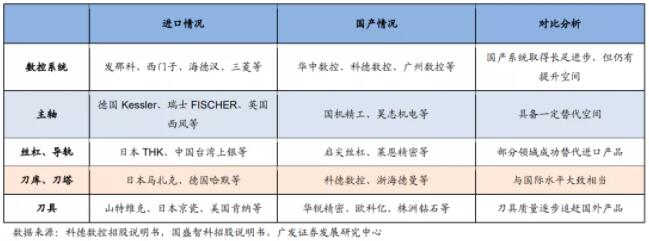
Chart: Machine Tool Core Parts Supplier
The general product life of machine tools is about 10 years. After the global machine tool consumption and output value reached its peak in 2011, it fell back, and then entered a decade-long downward cycle. According to NTMA statistics, global machine tool consumption in 2019 was US$82.1 billion, a year-on-year decrease of 13.8%. The global industry is still at the bottom of the cycle. According to Gardner Intelligence statistics, global machine tool consumption in 2019 was US$82.1 billion, a year-on-year decrease of 13.8%. Currently, the global industry is still at the bottom of the cycle. However, according to domestic conditions, PMI has been above the line of prosperity for 12 consecutive months, and the output of metal cutting machine tools in 2020 has also rebounded from the previous year. Considering that the machine tool industry takes a 10-year cycle, and the previous round reached its peak in 2011, 2020 may become the starting point for a new cycle.
The prelude to the merger and reorganization of the domestic machine tool industry has begun, and the competitive landscape is expected to continue to optimize. In April and December 2019, China General Technology Group successively implemented the reorganization of Dalian Machine Tool Group and Shenyang Machine Tool Group, marking that the curtain of accelerating the integration of the domestic machine tool industry has begun. Upgrading ushered in a peak. In the three years 2010-2012, when the demand was the strongest, 2.38 million metal cutting machine tools were produced, and 720,000 metal forming machine tools were produced. This part is a potential update demand. Today, 10 years later, the domestic machine tool industry has ushered in the peak of stock replacement.
The global machine tool market is 100 billion U.S. dollars, and China is the largest producer and consumer.
According to Gardner's data, global machine tool consumption in 2019 was US$82.1 billion, a decrease of US$13.1 billion, a year-on-year decrease of 13.8%, which was the lowest point since 2010. Similar to consumption, the global machine tool output in 2019 was US$84.2 billion, a decrease of US$12.9 billion, a year-on-year decrease of 13.3%, which is also the lowest level since 2010. The global machine tool industry is still at the bottom of the cycle. According to the "World Machine Tool Report Shows the Shift of Manufacturing Industry to North America" released by NTMA, most of the shrinkage of the global machine tool market since 2011 is attributed to China. In 2019, China’s machine tool consumption was US$22.3 billion, a decrease of US$6.4 billion, accounting for nearly half of the total global reduction; China’s machine tool output in 2019 was US$19.4 billion, a decrease of US$4.6 billion. In the past 8 years, China’s machine tools accounted for 6 Annual output has fallen.
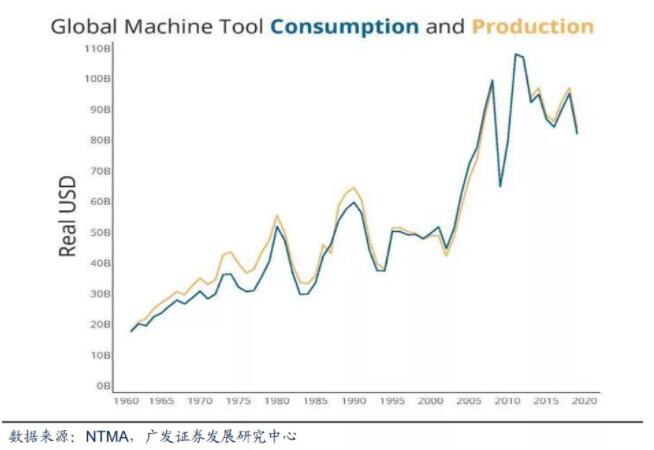
my country has been the world's largest producer, consumer and importer of machine tools since 2009. In 2019, my country's total machine tool production was 19.42 billion U.S. dollars, accounting for 23.10% of the world's total, and the total machine tool consumption was 22.3 billion U.S. dollars, accounting for 27.16% of the world's total.
“Big but not strong”, the high-end field lacks core competitiveness
Japan, Germany and the United States occupy a leading position, and my country's machine tool industry is "big but not strong". From the perspective of corporate profitability, most of the machine tool giants are concentrated in Japan, Germany, and the United States. Japan's leading machine tool company Yamazaki Mazak's operating income in 2019 was 35.904 billion yuan, while the combined operating income of the 10 machine tool companies in my country with the highest operating income in 2019 was only 11.254 billion yuan, which is 31.34% of the Yamazaki Mazak family's operating income. The profitability of my country's machine tool companies is far lower than that of overseas giants.
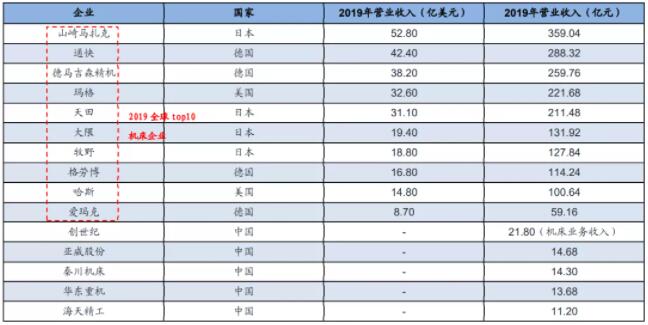
Chart: Comparison between domestic machine tool companies and overseas machine tool companies in 2019
In terms of import and export structure, although my country has become the world's largest importer of machine tools and one of the largest exporters, there are big differences in the structure of import and export products. In 2018, CNC forging or stamping machine tools and vertical machining centers accounted for 84% of my country's CNC machine tool imports, while CNC horizontal machine tools, CNC bending and folding or leveling machines accounted for 55% of export products, reflecting the technical content of my country's export products. Still low.
From the perspective of product prices, the average price of imported machine tool products is much higher than the average price of exported products. In December 2019, the average import price of metal processing machine tools in my country was US$123,900, and the average import price of CNC machine tools was US$283,800, while the average price of metal processing machine tools exported from my country was only US$326.45. There is a huge gap between the two.
For medium and low-end CNC machine tools, mechanical and electrical components and CNC systems can basically be domestically produced. Various components are supplied by multiple suppliers, and there is basically no problem of "stuck neck". Domestic CNC The performance and quality of domestically produced products achieved by advanced machine tool enterprises are not significantly different from those of international advanced enterprises.
For high-end CNC machine tools, from the perspective of the development of domestic high-end CNC machine tools and supporting supply chains, in addition to some parts of five-axis CNC machine tools, there are "stuck necks", other high-end CNC machine tools and CNC systems are basically Localization can be achieved, but the machining accuracy and reliability of some core key components are insufficient, and the CNC system functions are relatively backward. The performance and quality of the localized CNC machine tools are temporarily unable to reach the level of foreign advanced enterprises.
We should see that the localization of core parts of CNC machine tools is a dynamic process, which cannot be achieved overnight, but can only be achieved gradually. We should not ignore the efforts and achievements made by domestic manufacturers in recent years. Take Kede CNC as an example, the CNC system, servo drives, motors, spindles, dual-axis turntables, and tool magazines are all self-made. Only the guide rails, lead screws and sensors are self-made or purchased. This shows that the localization of CNC machine tools is accelerating.
The competitiveness of domestic enterprises has gradually increased. Comparing the domestic Kede CNC company with similar products from Hamer, Mikron, Demaghi and Okuma abroad, it can be found that the speed of the CNC spindle of Kede reached 18000ppm, which exceeded the German average value of selected samples by 15000ppm, reaching the international advanced level; X stroke reached 800mm, not much different from foreign countries; XYZ positioning accuracy/repetitive positioning accuracy reaches 0.005mm/0.003mm, AC positioning accuracy/repetitive positioning accuracy reaches 5”/3”, it is the highest precision machine tool in the sample.
China's CNC machine tool industry has developed rapidly since the late 1990s, and has evolved from the past incremental development to the current stage of optimized inventory. For example, in recent years, the demand for CNC machine tools has been the largest in automobiles, aerospace, and molds. The fields are all developing towards lightweight, multi-configuration and low-cost manufacturing. The use of new materials is becoming more and more extensive, and higher and higher requirements are placed on the processing capabilities of CNC machine tools. However, my country's machine tool industry has formed a production system dominated by medium and low-end machine tools. Due to the low threshold of the low-end CNC machine tool industry, there are many companies entering it. In recent years, the effective demand for the low-end CNC machine tool market has been insufficient, and there has been overcapacity in this field. Phenomenon.
On the other hand, China’s manufacturing industry is in a critical period of “two industrializations” integrated development and promotion of industrial structure adjustment and upgrading. Play an important role in the development of integration of technologies. With the development of the national economy and the upgrading of the industrial structure, the application of medium and high-end CNC machine tools has become more and more popular, and the demand for products is increasing, but the supply is difficult to meet the demand.
The added value of low-end products trade is low, and the transition to high-end products is urgent. The supply of my country's machine tool industry is still dominated by low-end products. The supply capacity of low-end products is obviously surplus, while the supply of high-end products is obviously insufficient. According to the "Analysis of the Competition Pattern and Development Prospects of China's CNC Machine Tool Industry in 2019" issued by the Qianzhan Industry Research Institute, the localization rate of my country's low-end CNC machine tools in 2018 was 82%, basically achieving localization; the localization rate of mid-range CNC machine tools was 65% , At a relatively low level; the localization rate of high-end CNC machine tools is only 6%, mainly relying on imports.
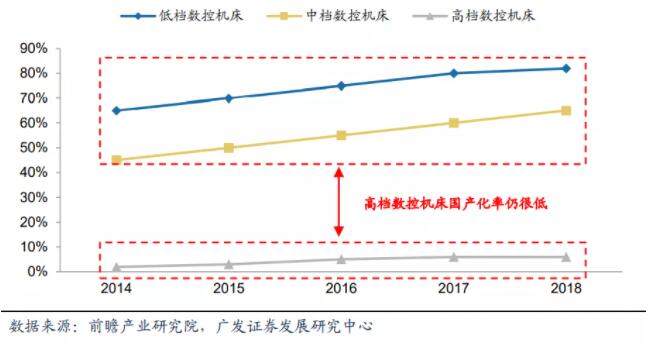
Chart: Localization rate of different CNC machine tools in my country (%)
my country's newly-added CNC machine tools have maintained a steady growth in recent years, mainly related to industrial transformation and upgrading. With the complexity of the structure of processed products, the continuous improvement of processing accuracy requirements and the improvement of production efficiency, my country's machine tool equipment is gradually transitioning from traditional ordinary machine tools to CNC machine tools. The rate of newly added metal cutting machine tools in my country has increased from 26% in 2012 to 43% in 2020. According to the "Made in China 2025" plan, it is expected that the CNC rate of key processes in my country will reach 50% during the 14th Five-Year Plan period, while the CNC rate of machine tools in developed countries is generally above 80%. Relatively speaking, the degree of CNC metal cutting machine tools in my country There is a lot of room for improvement.
Source: GF Securities




